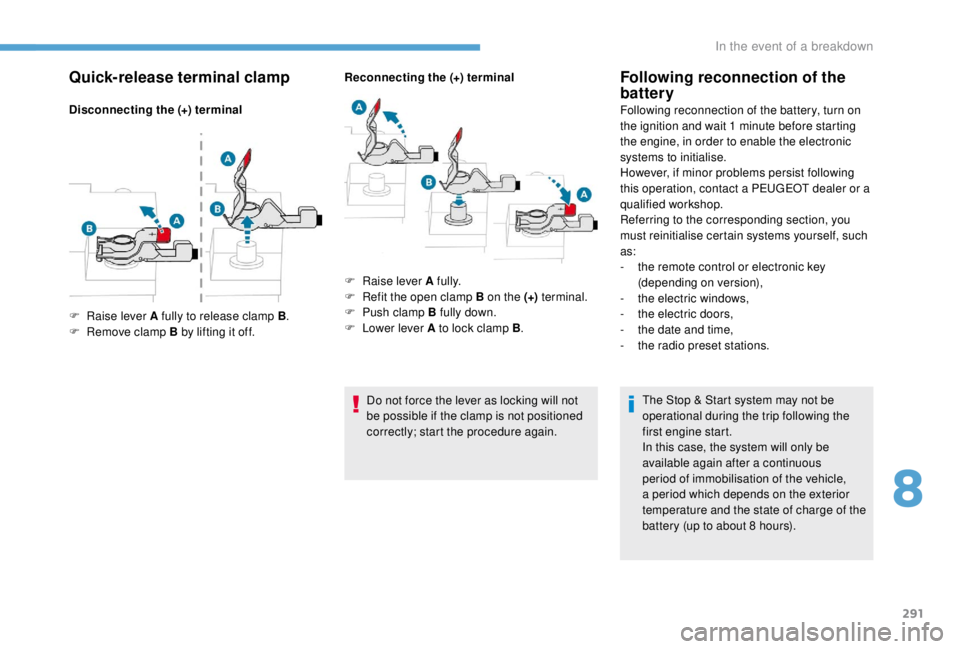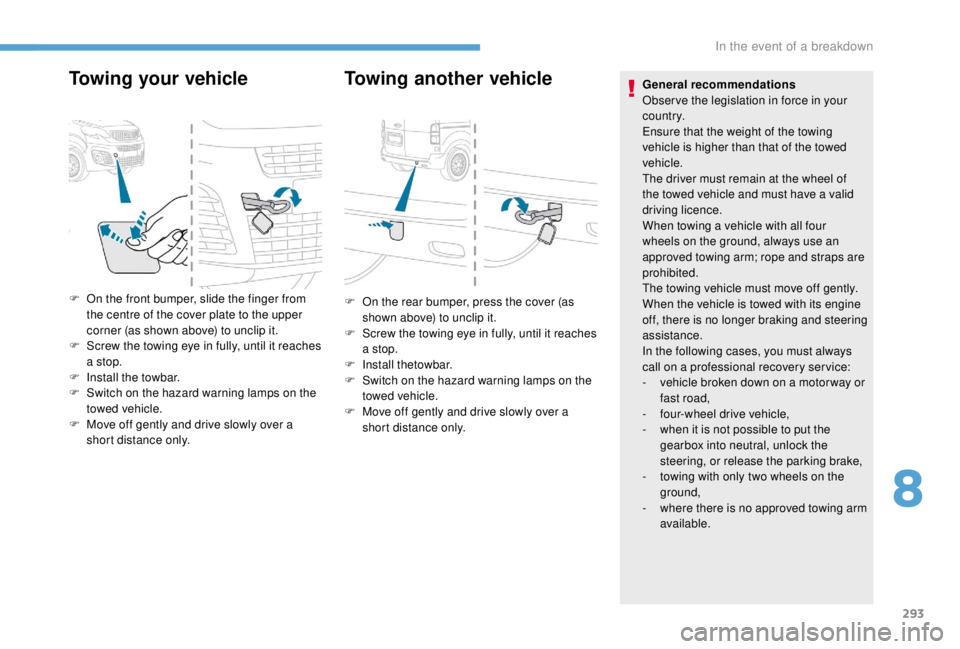Page 293 of 416

291
Quick-release terminal clamp
Disconnecting the (+) terminalReconnecting the (+) terminal
Do not force the lever as locking will not
be possible if the clamp is not positioned
correctly; start the procedure again.
Following reconnection of the
battery
Following reconnection of the battery, turn on
the ignition and wait 1 minute before starting
the engine, in order to enable the electronic
systems to initialise.
However, if minor problems persist following
this operation, contact a PEUGEOT dealer or a
qualified workshop.
Referring to the corresponding section, you
must reinitialise certain systems yourself, such
as:
-
t
he remote control or electronic key
(depending on version),
-
t
he electric windows,
-
t
he electric doors,
-
t
he date and time,
-
t
he radio preset stations.The Stop & Start system may not be
operational during the trip following the
first engine start.
In this case, the system will only be
available again after a continuous
period of immobilisation of the vehicle,
a period which depends on the exterior
temperature and the state of charge of the
battery (up to about 8
hours).
F
Ra
ise lever A fully to release clamp B .
F
R
emove clamp B by lifting it off. F
Ra
ise lever A fully.
F
R
efit the open clamp B on the (+) terminal.
F
P
ush clamp B fully down.
F
L
ower lever A to lock clamp B .
8
In the event of a breakdown
Page 294 of 416
292
Battery capacity
Vehicle lengthRating in Ah
(Ampere hours)
Compact 480
Standard 640
Long 720
/ 800
Always replace the battery with one of
equivalent specification.
To w i n g
Procedure for having your vehicle towed or
for towing another vehicle using a removable
towing eye.
Access to the tools
For more information on the Tool box ,
refer to the corresponding section.
With a manual gearbox, move the gear
lever into neutral.
With an automatic or electronic gearbox,
place the gear selector into position N .
Failure to adhere to this specification
may lead to damage to braking system
components and the lack of braking
assistance on restarting the engine.
The towing eye is stowed in the tool box.
In the event of a breakdown
Page 295 of 416

293
Towing your vehicleTowing another vehicle
F On the front bumper, slide the finger from
the centre of the cover plate to the upper
corner (as shown above) to unclip it.
F
S
crew the towing eye in fully, until it reaches
a stop.
F
I
nstall the towbar.
F
S
witch on the hazard warning lamps on the
towed vehicle.
F
M
ove off gently and drive slowly over a
short distance only. General recommendations
Obser ve the legislation in force in your
c o u nt r y.
Ensure that the weight of the towing
vehicle is higher than that of the towed
vehicle.
The driver must remain at the wheel of
the towed vehicle and must have a valid
driving licence.
When towing a vehicle with all four
wheels on the ground, always use an
approved towing arm; rope and straps are
prohibited.
The towing vehicle must move off gently.
When the vehicle is towed with its engine
off, there is no longer braking and steering
assistance.
In the following cases, you must always
call on a professional recovery ser vice:
-
v
ehicle broken down on a motor way or
fast road,
-
f
our-wheel drive vehicle,
-
w
hen it is not possible to put the
gearbox into neutral, unlock the
steering, or release the parking brake,
-
t
owing with only two wheels on the
ground,
-
w
here there is no approved towing arm
available.
F
O n the rear bumper, press the cover (as
shown above) to unclip it.
F
S
crew the towing eye in fully, until it reaches
a stop.
F
I
nstall thetowbar.
F
S
witch on the hazard warning lamps on the
towed vehicle.
F
M
ove off gently and drive slowly over a
short distance only.
8
In the event of a breakdown
Page 296 of 416

294
Characteristics of the
engines and towed loads
Engines
The engine characteristics are given in the
vehicle's registration document, as well as in
sales brochures.The maximum power corresponds to the
value type-approved on a test bed, under
conditions defined in European legislation
(Directive 1999/99/EC).
For more information, contact a PEUGEOT
dealer or a qualified workshop.
Weights and towed loads
The maximum weights and towed loads for
your vehicle are given in the registration
document, as well as in sales brochures.
These values are also given on the
manufacturer's plate or label.
For more information, contact a PEUGEOT
dealer or a qualified workshop.
The GTW values and the towable loads
listed are valid for a maximum altitude of
1,000
metres. The towable load must be
reduced by steps of 10% for each additional
1,000
metres.
The recommended nose weight is the vertical
load on the towbar ball (removable, with or
without tools).
GT W: Gross train weight. High exterior temperatures may result
in a reduction in the per formance of the
vehicle to protect the engine. When the
exterior temperature is higher than 37°C,
limit the towed weight.
Towing using a lightly loaded vehicle can
adversely affect roadholding.
Braking distances are increased when
towing a trailer.
When using a vehicle to tow, never exceed
a speed of around 60
mph (100 km/h)
(obser ve the local legislation in force).
If the exterior temperature is high, it is
recommended that the engine be allowed
to idle for 1
to 2 minutes after the vehicle
comes to a stop, to facilitate its cooling.
Technical data
Page 297 of 416
295
Diesel EURO 5 engines and towed loads
Engines1.6 litre HDi 902 litre HDi 150
Gearbox Manual 5-speed (BVM5) Manual 6-speed (BVM6)Automatic 6-speed (EAT6)
Code DV6DUDW10F
Regulatory engine type BHVAHX
Length L1 , L 2L1*, L 2 *, L 3 * L1 , L 2L1*, L 2 *, L 3 * L1 , L 2L1*, L 2 *, L 3 *
Capacity (cm
3) 1,5 6 01,9 97
Max power: CEE standard (kW) 6611 0
Fuel Diesel
Braked trailer (within
the GTW limit) on a 12%
slope 2
seats 6001,1 0 0 800
3
seats 6001,1 0 0 800
Unbraked trailer 2-3
seats 600 750
Recommended nose
weight (kg)
or
Vertical load 2-3
seats 25 44 32
*
I
ncreased payload.
9
Technical data
Page 298 of 416
296
Diesel EURO 6.1 engines and towed loads
Engines1.6 litre BlueHDi
95 1.6
litre BlueHDi
95 S&S1.6
litre BlueHDi
115 S & S
Gearbox Manual 5-speed
(BVM5) Electronic 6-speed
(ETG6) Manual 6-speed
(BVM 6)
Code DV6FDUDV6FDUDV6FCU
Regulatory engine type BHVBHSBHX
Length L1 , L 2L1*, L 2 *, L 3 * L1 , L 2L1*, L 2 *, L 3 * L1 , L 2
Capacity (cm
3) 1,5 6 0
Max power: CEE standard (kW) 707085
Fuel Diesel
Braked trailer (within
the GTW limit) on a 12%
slope 2
seats 1,8 0 02,000 1,8 0 02,000 1,8 0 0
3
seats 1,8 0 02,000 1,8 0 02,000 1,8 0 0
Unbraked trailer 2-3
seats 750
Recommended nose
weight (kg)
or
Vertical load 2-3
seats7280 7280 72
*
I
ncreased payload.
Technical data
Page 299 of 416
297
Engines2 litre
BlueHDi 120 2
litre
BlueHDi
120 S&S2
litre
BlueHDi
15 0 S&S2
litre
BlueHDi
180 S&S
Gearbox Manual
6-speed (BVM 6) Manual
6-speed (BVM 6) Manual
6-speed (BVM 6) Automatic
6-speed ( E AT 6)
Code DW10FE DW10FEDW10FDDW10FC
Regulatory engine type AHK AHKAHXAHH
Length L1*, L 2 *, L 3 * L1*, L 2 *, L 3 *L1 , L 2L1*, L 2 *, L 3 * L1 , L 2L1*, L 2 *, L 3 *
Capacity (cm
3) 1,9 97
Max power: CEE standard (kW) 9011 0 13 0
Fuel Diesel
Braked trailer (within
the GTW limit) on a 12%
slope 2
seats 2,500 2,500 2,300 2,500 2,0002,200
3
seats 2,500 2,500 2,300 2,500 2,0002,200
Unbraked trailer 2-3
seats 750
Recommended nose
weight (kg)
or
Vertical load 2-3
seats10 010 0 9210 0 8088
*
I
ncreased payload.
9
Technical data
Page 300 of 416
298
Diesel EURO 4 and 5 engines and towed loads
Engines1.6 litre HDi 902 litre HDi 1502 litre BlueHDi 150
Gearbox Manual 5-speed
(BVM5) Manual 6-speed
(BVM 6) Automatic
6-speed (EAT6) Manual 6-speed
(BVM 6) Automatic
6-speed (EAT6)
Code DV6DUDW10F DW10FD
Regulatory engine type 9HHAHX AHX
Length L1, L2,
L3 L 2 *,
L3* L1, L2,
L3 L 2 *,
L3* L1, L2,
L3 L 2 *,
L3* L1, L2,
L3 L 2 *,
L3* L1, L2,
L3 L 2 *,
L3*
Cubic capacity (cm
3) 1,5 6 01,9 97 1,9 97
Max power: CEE standard (kW) 6611 0 11 0
Fuel Diesel
Braked trailer (within
the GTW limit) on a 12%
slope 8
seats 6001,1 0 0 8001,1 0 0 800
9
seats 6001,1 0 0 8001,1 0 0 800
Unbraked trailer 8-9
seats 600 750
Recommended nose
weight (kg)
or
Vertical load 8-9
seats 2544 3244 32
*
I
ncreased payload.
Technical data